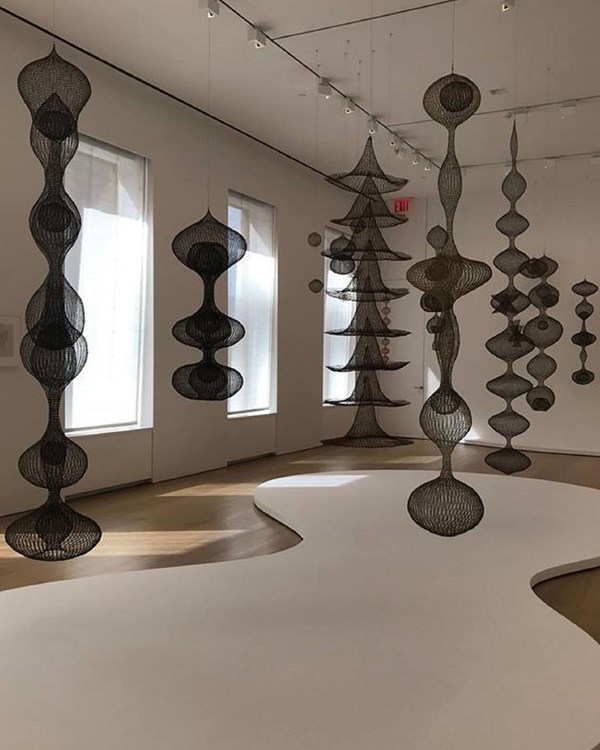Last updated: March 30, 2022
Person
Ruth Asawa

Photo by By Angel2u4now, CC BY-SA 4.0, https://commons.wikimedia.org/w/index.php?curid=63428437
Ruth Asawa was an American modernist sculptor. She grew up in California. During World War II, the US government incarcerated Asawa and her family because of their Japanese ancestry. After the end of the war, Asawa enrolled in art school at Black Mountain College in North Carolina, which welcomed women and people of color despite the state's segregation. Her distinctive wire sculpture became internationally famous.
What challenges have you overcome in your life? How did these experiences shape the person you’ve become?
Ruth Asawa was born in southern California in 1926. Her parents immigrated from Japan before her birth and worked as farmers. Due to discriminatory laws, her parents were unable to apply for US citizenship. The fourth of seven children, Asawa helped her parents grow, harvest, and sell produce.
Asawa’s life was uprooted after Japan bombed the American Naval Base in Pearl Harbor, Hawai’i in December 1941. In response, the US government declared war on Japan and officially entered World War II. Fearing that people of Japanese descent would sympathize with Japan, President Franklin Delano Roosevelt issued Executive Order 9066. An executive order is a rule or law that can only be issued by a sitting president. Executive Order 9066 forced all Japanese and Japanese Americans in the US to relocate to internment camps. Even though people like Asawa and her siblings were American citizens, the government forcibly detained them for the duration of the war.
In February of 1942, law enforcement arrested Asawa’s father and imprisoned him in a labor camp in New Mexico. He remained separated from his family until 1948. Only a few months after her father was arrested, Ruth and her family were forced to leave their farm and all of their belongings. They spent the next six months at the Santa Anita racetrack in Los Angeles living in a smelly horse stable. In late 1942, the Asawa family was forcibly taken to Rohwer War Relocation Center in Arkansas. Significant for its association with World War II and the incarceration process, Rohwer was designated a National Historic Landmark in 1992. While the structures were demolished, the Rohwer Relocation Center Memorial Cemetery still stands. It is one of only three existing Japanese American relocation center cemeteries in the United States.
Asawa spent her teenage years confined at Rohwer until the end of World War II in 1945. While incarcerated, she attended high school in the camp and studied art. She even volunteered as the art editor for the school yearbook.
Shortly after the US government released her family from Rohwer in 1945, Asawa enrolled in art school at Black Mountain College in North Carolina. Founded in 1933, the experimental school was internationally known for its modernist advancements in American art and education. Today, the Black Mountain College Historic District is listed in the National Register of Historic Places for its association with famous artists like Asawa. Even though schools in the South were still segregated, the college welcomed women and people of color and offered opportunities for students to learn and express their creativity. Asawa spent three years at Black Mountain College where she met her future husband, architect Albert Lanier.
Asawa and Lanier married and moved to San Francisco where they had six children. Asawa had little free time to create her art and often spent late evenings in her home studio. She developed her own style creating sculptures with industrial wire. Experimenting with different forms, Asawa challenged popular expectations of what defined a “sculpture” by twisting and molding the wire. Her work was eventually displayed in galleries in San Francisco and New York City.
In addition to becoming an internationally famous artist, Asawa also advocated for art education. She founded the Alvarado School Arts Workshop, a program that enlisted professional artists to teach public school students.
Asawa died in 2013. Her art continues to be featured in galleries in the US and Europe.
For more Asian American and Pacific Islander stories, visit the National Park Service’s AAPI Heritage website.
Bibliography
Chase, Marilyn. Everything She Touched: Life of Ruth Asawa. Chronicle Books, 2020.
D’Souza, Aruna. Ruth Asawa: Life’s Work. Yale University Press, 2019.
Ruth Asawa Website, https://ruthasawa.com/, accessed May 4th, 2021.
